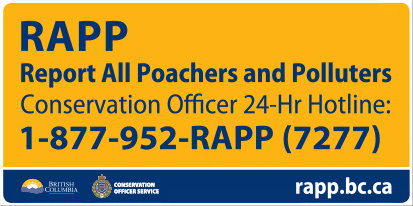Clean, Drain, Dry
Practice Clean, Drain and Dry
Pull the plug! It’s the law in B.C.
It is illegal to transport watercraft (including boats, kayaks, canoes and paddle boards), water-related equipment or aircraft on land, unless all drainage holes, valves or other devices used to drain water are left open or unplugged.
- Alternatively, a boat can be transported in an inverted manner if it allows the interior of the boat to be drained. This includes draining any ballast tanks, bilge areas or compartments
Why is this important? While B.C. is currently free of invasive mussels, Whirling Disease has been detected in B.C.
- To help stop the spread of whirling disease and invasive mussels before moving a boat or any equipment between water bodies, be sure to Clean, Drain, Dry
To help prevent the spread of aquatic invasive species such as invasive mussels, the Clean, Drain and Dry steps outlined below should be followed for all boats and equipment (waders, life jackets, kayaks, et cetera) before moving between waterbodies.
Clean:
- Inspect and clean all watercraft, trailers, and equipment on dry land away from storm water drains, ditches and waterways
- Remove all mud, sand and plant materials before leaving the shore. Rinse or wash your boat and equipment away from storm drains, ditches or waterways
- Some aquatic invasive species are very small such as invasive mussels and can be found in small amounts of water, mud or dirt. Pay attention to hidden, hard to reach areas, gaps, crevices, holes and other inconspicuous places
Drain:
- Before leaving a waterbody, drain all water on dry land (including all internal compartments such as ballasts, bilges, and live wells), coolers, life jackets and other gear
- Raise and lower outboard engines several times to ensure all water has drained out
- Drain non-motorized watercraft by inverting or tilting the watercraft, opening compartments and removing seats if necessary
- Pull the plug! In B.C., it is illegal to transport watercraft (including boats, kayaks, canoes and paddle boards), water-related equipment or aircraft on land, unless all drainage holes, valves or other devices used to drain water are left open or unplugged
Dry:
- Watercraft and equipment must be completely dry before entering new waters and this includes allowing all wet areas to air dry completely
- Leave compartments open on boats and equipment
If possible, avoid launching a watercraft into more than one waterbody per day (depending on weather conditions) to allow time for boat and gear to dry. The use of felt-soled waders is strongly discouraged, as they are a potential pathway for the dispersal of aquatic invasive species, and particularly difficult to disinfect. Rubber-soled alternatives are available on the market, and provide the same non-slip qualities, but are much easier to clean.
Clean, Drain, and Dry versus decontamination
Clean, Drain, and Dry is a preventative step that all boaters should practice when moving any watercraft or water equipment between waterbodies to prevent the spread of aquatic invasive species. This includes boats that are just moving between lakes in BC to prevent the spread of species already present in some lakes but not others such as Eurasian watermilfoil.
Decontamination is applied when there is an identified risk that a conveyance (either watercraft or water equipment) may be transporting AIS. The Provincial auxiliary conservation officers are trained at identifying and treating the risk of transporting AIS through specified decontamination procedures. For invasive mussels decontamination procedures involve hot water with specific contact times to kill the mussels and high pressure to remove them.
Report Invasive Mussels
Any suspected, transport, possession, sale or release of invasive mussels should be reported immediately to the Conservation Officer Services Report All Poachers and Polluters: 1-877-952-7277 (RAPP).

Report Invasive Species
- Any invasive species sightings in B.C. should be reported using the Report-Invasives B.C. apps for iPhone and iPad or Android
- Learn more about other terrestrial and aquatic invasive species
- Learn more about whirling disease


